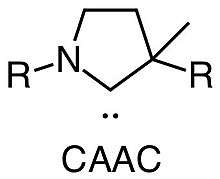Cyclic alkyl amino carbenes
In chemistry, cyclic(alkyl)(amino)carbenes (CAACs) are a family of stable singlet carbene ligands developed by Prof. Guy Bertrand and his group in 2005 at UC Riverside (now at UC San Diego).[1] In marked contrast with the popular N-heterocyclic carbenes (NHC) which possess two "amino" substituents adjacent to the “carbene” center, CAACs possess one "amino” substituent and an sp3 carbon atom “alkyl”. This specific configuration makes the CAACs very good σ-donors (higher HOMO) and π-acceptors (lower LUMO) when compared to NHCs. Moreover the reduced heteroatom stabilization of the carbene center in CAACs versus NHCs also gives rise to a smaller ΔEST (48.3 vs 72.7 kcal mol-1).

Synthesis
The original preparation of some CAACs begins with condensation of 2,6-diisopropylaniline and 2-methylpropanal. Deprotonation of this aldimine with lithium diisopropylamide gives an aza-allyl anion, which ring opens 1,2-epoxy-2-methylpro-pane. The resulting lithium alkoxide is then treated with triflic anhydride to generate the aldiminium salt. The final step in the synthesis uses lithium diisopropylamide to generate the carbene, which is a moisture sensitive is a white solid.[1]

Applications
In recent years, cyclic (alkyl)(amino)carbenes have found numerous applications ranging from the stabilization of highly reactive species, to homogeneous catalysis and materials.[2],[3] Better σ-donors and π-acceptors than the well-known N-heterocyclic carbenes (NHCs), these stable singlet carbene are well known for stabilising highly reactive species, such as highly reactive low valent complexes,[4] and main group radicals.[5][6]
As ligand for transition metal catalysts, they distinguished themselves in ruthenium catalysis ethenolysis processes where CAACs proved to be superior compared to NHCs reaching up to 340000 TONs.[7] Note that this was the first time ruthenium metathesis catalysts exhibited high performance in cross‐metathesis reactions employing ethylene gas, with activities sufficient for the industrial‐scale production of linear α‐olefins (LAOs) and other terminal‐olefin products.
More recently, CAACs have been shown by Di et al.[8] and Thompson et al.[9] to generate very efficient OLEDs materials with d10-coinage metals.[10] Traditionally, OLED devices rely on expensive heavy transition metals such as iridium, platinum, or ruthenium which are not sustainable. Consequently, the development of d10-coinage metal alternatives is inherently more advantageous .
It was also demonstrated that their ambiphilic nature allows them to participate in the activation of enthalpically strong E-H bonds (E: N, P, Si, …),[11] a distinctive feature traditionally reserved to transition metals. It was also shown that bulky CAACs promote the reverse transformation,[12] a formal reductive elimination of E-H bonds at carbon, further delineating the parallel with transition metals.
References
- Lavallo, Vincent; Canac, Yves; Präsang, Carsten; Donnadieu, Bruno; Bertrand, Guy (2005-09-05). "Stable Cyclic (Alkyl)(Amino)Carbenes as Rigid or Flexible, Bulky, Electron-Rich Ligands for Transition-Metal Catalysts: A Quaternary Carbon Atom Makes the Difference". Angewandte Chemie International Edition. 44 (35): 5705–5709. doi:10.1002/anie.200501841. ISSN 1521-3773. PMC 2427276. PMID 16059961.
- Soleilhavoup, Michèle; Bertrand, Guy (2015-02-17). "Cyclic (Alkyl)(Amino)Carbenes (CAACs): Stable Carbenes on the Rise". Accounts of Chemical Research. 48 (2): 256–266. doi:10.1021/ar5003494. ISSN 0001-4842.
- Melaimi, Mohand; Jazzar, Rodolphe; Soleilhavoup, Michèle; Bertrand, Guy (2017). "Cyclic (Alkyl)(amino)carbenes (CAACs): Recent Developments". Angewandte Chemie International Edition. 56 (34): 10046–10068. doi:10.1002/anie.201702148. ISSN 1521-3773.
- Roy, Sudipta; Mondal, Kartik Chandra; Roesky, Herbert W. (2016-03-15). "Cyclic Alkyl(amino) Carbene Stabilized Complexes with Low Coordinate Metals of Enduring Nature". Accounts of Chemical Research. 49 (3): 357–369. doi:10.1021/acs.accounts.5b00381. ISSN 0001-4842.
- Kundu, Subrata; Sinhababu, Soumen; Chandrasekhar, Vadapalli; Roesky, Herbert W. (2019-05-08). "Stable cyclic (alkyl)(amino)carbene (cAAC) radicals with main group substituents". Chemical Science. 10 (18): 4727–4741. doi:10.1039/C9SC01351B. ISSN 2041-6539.
- Ullrich, Tobias; Pinter, Piermaria; Messelberger, Julian; Haines, Philipp; Kaur, Ramandeep; Hansmann, Max M.; Munz, Dominik; Guldi, Dirk M. (2020). "Singlet Fission in Carbene-Derived Diradicaloids". Angewandte Chemie International Edition. 59 (20): 7906–7914. doi:10.1002/anie.202001286. ISSN 1521-3773.
- Marx, Vanessa M.; Sullivan, Alexandra H.; Melaimi, Mohand; Virgil, Scott C.; Keitz, Benjamin K.; Weinberger, David S.; Bertrand, Guy; Grubbs, Robert H. (2015). "Cyclic Alkyl Amino Carbene (CAAC) Ruthenium Complexes as Remarkably Active Catalysts for Ethenolysis". Angewandte Chemie International Edition. 54 (6): 1919–1923. doi:10.1002/anie.201410797. ISSN 1521-3773. PMC 4713124. PMID 25522160.
- Di, Dawei; Romanov, Alexander S.; Yang, Le; Richter, Johannes M.; Rivett, Jasmine P. H.; Jones, Saul; Thomas, Tudor H.; Jalebi, Mojtaba Abdi; Friend, Richard H.; Linnolahti, Mikko; Bochmann, Manfred (2017-04-14). "High-performance light-emitting diodes based on carbene-metal-amides". Science. 356 (6334): 159–163. doi:10.1126/science.aah4345. ISSN 0036-8075. PMID 28360136.
- Hamze, Rasha; Peltier, Jesse L.; Sylvinson, Daniel; Jung, Moonchul; Cardenas, Jose; Haiges, Ralf; Soleilhavoup, Michele; Jazzar, Rodolphe; Djurovich, Peter I.; Bertrand, Guy; Thompson, Mark E. (2019-02-08). "Eliminating nonradiative decay in Cu(I) emitters: >99% quantum efficiency and microsecond lifetime". Science. 363 (6427): 601–606. doi:10.1126/science.aav2865. ISSN 0036-8075. PMID 30733411.
- Jazzar, Rodolphe; Soleilhavoup, Michele; Bertrand, Guy (2020-05-13). "Cyclic (Alkyl)- and (Aryl)-(amino)carbene Coinage Metal Complexes and Their Applications". Chemical Reviews. 120 (9): 4141–4168. doi:10.1021/acs.chemrev.0c00043. ISSN 0009-2665.
- Frey, G. D.; Lavallo, V.; Donnadieu, B.; Schoeller, W. W.; Bertrand, G. (2007-04-20). "Facile Splitting of Hydrogen and Ammonia by Nucleophilic Activation at a Single Carbon Center". Science. 316 (5823): 439–441. doi:10.1126/science.1141474. ISSN 0036-8075.
- Tolentino, Daniel R.; Neale, Samuel E.; Isaac, Connie J.; Macgregor, Stuart A.; Whittlesey, Michael K.; Jazzar, Rodolphe; Bertrand, Guy (2019-06-26). "Reductive Elimination at Carbon under Steric Control". Journal of the American Chemical Society. 141 (25): 9823–9826. doi:10.1021/jacs.9b04957. ISSN 0002-7863.